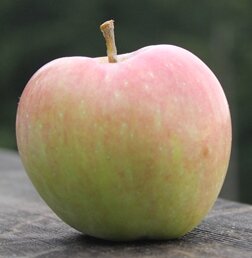Reinette du Canada
Why you should be excited
Reinette du Canada is an old apple – still revered by some in France – that’s got little to do with Canada.
The story of Reinette du Canada
I’ve read the history of this old French apple and still don’t have a clue as to how it got its name; it has little or nothing to do with Canada, the country. To further confuse things, this apple goes by some 152 different names.
We do know it was recorded in the 18th century but has been on the scene at least a century longer than that.
When picked early, it’s considered a top cooking apple, sour and flavourful; when picked later and stored, it morphs into a sweet and relatively dry eating apple. And even after three and a half centuries or so, Reinette du Canada continues to have a keen following.
So take note and don’t worry too much about the name.
Reinette du Canada Facts
Its origins
Origins are uncertain, but it was likely discovered in Normandy, France; first recorded in 1771.
Flavour, aroma, texture
Sweet and quite rich. Tart when used for cooking early in the season. When stored and then eaten fresh, the flesh becomes crumbling and sweeter.
Appearance
Medium to large in size, with a slight orange flush over greenish-yellow background skin colour.
When they’re available
Late season (usually in mid-October).
Quality for fresh eating
Good.
Quality for cooking
Good. Keeps its shape.
Keeping ability
Very good (as much as 4 or 5 months when kept refrigerated).



